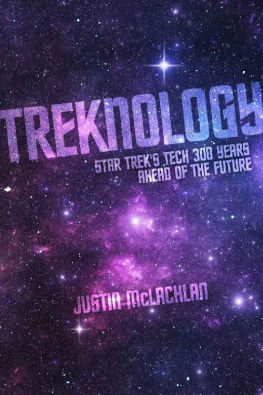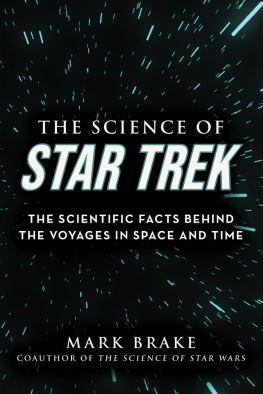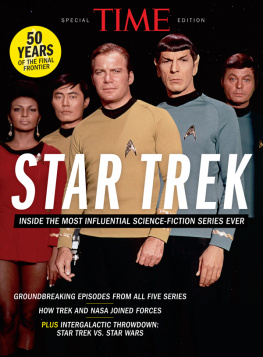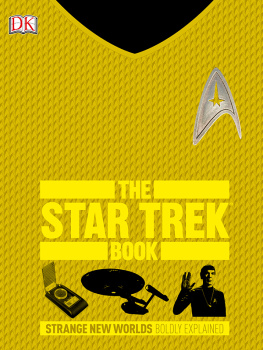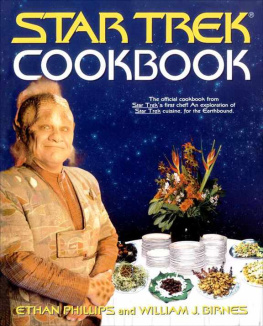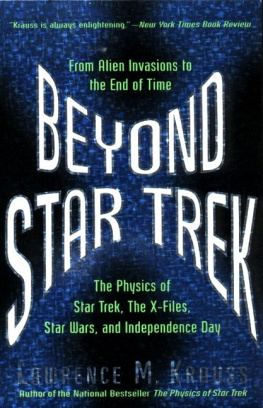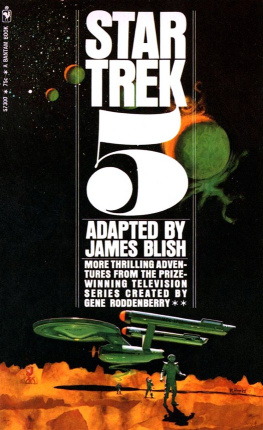Justin McLachlan - Treknology: Star Trek’s Tech 300 Years Ahead of the Future
Here you can read online Justin McLachlan - Treknology: Star Trek’s Tech 300 Years Ahead of the Future full text of the book (entire story) in english for free. Download pdf and epub, get meaning, cover and reviews about this ebook. year: 2013, genre: Art. Description of the work, (preface) as well as reviews are available. Best literature library LitArk.com created for fans of good reading and offers a wide selection of genres:
Romance novel
Science fiction
Adventure
Detective
Science
History
Home and family
Prose
Art
Politics
Computer
Non-fiction
Religion
Business
Children
Humor
Choose a favorite category and find really read worthwhile books. Enjoy immersion in the world of imagination, feel the emotions of the characters or learn something new for yourself, make an fascinating discovery.
- Book:Treknology: Star Trek’s Tech 300 Years Ahead of the Future
- Author:
- Genre:
- Year:2013
- Rating:3 / 5
- Favourites:Add to favourites
- Your mark:
- 60
- 1
- 2
- 3
- 4
- 5
Treknology: Star Trek’s Tech 300 Years Ahead of the Future: summary, description and annotation
We offer to read an annotation, description, summary or preface (depends on what the author of the book "Treknology: Star Trek’s Tech 300 Years Ahead of the Future" wrote himself). If you haven't found the necessary information about the book — write in the comments, we will try to find it.
Treknology: Star Trek’s Tech 300 Years Ahead of the Future — read online for free the complete book (whole text) full work
Below is the text of the book, divided by pages. System saving the place of the last page read, allows you to conveniently read the book "Treknology: Star Trek’s Tech 300 Years Ahead of the Future" online for free, without having to search again every time where you left off. Put a bookmark, and you can go to the page where you finished reading at any time.
Font size:
Interval:
Bookmark:
TREKNOLOGY
STAR TREK TECH 300 YEARS AHEAD OF THE FUTURE
JUSTIN McLACHLAN
BOX FIRE PRESS
For Craig.
Thanks to every person who patiently explained the nuances of things like robotics, holography and warp fields to meyour expertise has made Treknology possible. Also, thanks to everyone who took the time to review the book and offer advice: Craig, Scott and of course, my preternaturally detail-oriented cousin Jared, who can spot the difference between twenty-eight and twenty-seven zeroes at a glance.
TREKNOLOGY. Copyright 2013 by Justin McLachlan LLC. All rights reserved. No part of this book may be used or reproduced in any manner whatsoever without written permission except in the case of brief quotations embodied in critical articles and reviews. For information, please contact Boxfire Press at http://boxfirepress.com. eBook ISBN 9781938191107
Contents
Here, There and
Everywhere31
How to make
anything invisible55
FASTER THAN A SPEEDING
BULLET109
ABOUT JUSTIN
McLACHLAN186
Introduction
G rowing up, I was a bit of television whore. Scooby Doo, Batman, ThunderCats, Transformers, MacGyver . These shows consumed me. I ran around wearing a Batman cape, which my grandmother had cut and sewn for me, years beyond an appropriate age. I even once sent her on a quest to buy real Scooby-snacks, even though no such thing existed. Every car I rode in became a Batmobile and I Batman, despite never being allowed in the drivers seat. I even harbored a vague sense of expectation that the crossbars on the hilt of my toy Sword of Omens would morph if I just asked for sight beyond sight with enough conviction. That they never did was always a big disappointment. When the last episode of MacGyver aired and he drove off into the sunset on his motorcycle, I cried, actually, and told Richard Dean Anderson that he was a quitter and I hated him. Please dont tell anyone. I was only ten.
My point is that when I say consumed, I mean consumed. TV preoccupied me so much that my dad eventually decreed that I could watch just one hour a day. The pretext was that Id go outside and play instead, but I usually spent the day staring at a blank screen, waiting for prime time. Take that, Dad.
When I was older and it was clear the rule had failed, Dad did finally concede defeat and I actually got a TV for my room. It was my parents old, 19-inch television that theyd probably have just as soon thrown away, but it was a TV. In my bedroom. This was as life-changing as my first DVR. No cable, though. I had to rely on an antenna and some well-placed tin foil which, on a clear day, would pull one channel from a station in Pittsburgh. And every night at 7 p.m., that one channel aired a show that, even after my particularly bad breakup with MacGyver , would become my next love. It was called Star Trek: The Next Generation .
Id only vaguely heard of it. Id seen parts of an episode years earlier with my grandmother, and Id asked to her explain what a generation was. Even after a simple example (Im a generation, your mom is a generation and youre another generation, shed said) I still didnt quite get it. No matter. Something about TNG immediately captured my imagination and still hasnt let go. I got to a point where I could tell you what an episode was about if you gave me the title, or I could tell you the title if you told me what the episode was about. I even had the order and episode numbers memorized, thanks to a list in the Star Trek Magazine that was meant to be a ballot to vote for favorites episodes. I tore it out and kept it in a scrapbook.
I also collected Star Trek trading cards made by Impel. Every time I saved up $2.10, I went and bought a new pack at the only convenience store in town that sold them. I have an entire collection now, save a few special holographic cards that werent part of the normal set. I bought the Star Trek The Next Generation: Technical Manual and The Star Trek Encyclopedia , two books Ive relied on extensively to write Treknology . On birthdays and holidays, I got Star Trek toys as presents. My favorite was the phaser (type II), though the sound effects on my Enterprise model were awesome. I also had a Romulan Warbird and a Klingon Battle Cruiser. I had a working model of the Enterprise-Ds bridge and a toy transporter with a two-way mirror inside it to make all my Star Trek action figures appear and disappear. I collected every Micro Machine ship cast, and then displayed them on a shelf above my desk well into high school.
You did remember that I said consumed, right?
Years later, when I was living in San Diego and working as a freelance writer, JJ Abrams was about to reboot the Star Trek franchise. I wrote a short article for the now-defunct San Diego News Network about a few pieces of Star Trek technology that had already arrived, 300 years ahead of the future. I did an interview for a local radio station the day the film opened, and I think they were most surprised about one of my technological pronouncements. Ill get to what it was later, in the first chapter, actually, but it got me thinkingis there more of Star Treks technology already here or soon to come than we realize? How much of what we take for granted, like say, touchscreens, do we owe these shows?
So, I set off on a mission to find out. Unlike other works written on this subject, like the seminal The Physics of Star Trek by Lawrence Krauss, to which I owe a debt of gratitude for its expertise, I dont rely on my own knowledge of science. Instead, I talked to experts and did a lot of research, distilled here to the simplest and finest points. I scanned our technological horizon to find out just where we are, and where were about to boldly go. I make few predictions, but a lot of comparisons. The fact is, and you might disagree at first, even viscerally, a lot of what weve seen in Star Trek is already here, or well on its way. Ill explain it in more detail, but trust me. When you start to examine the current state of technology with an eye toward fiction like Star Trek, you see the parallels between art and life everywhere. In this case, life really does imitate art, just a lot sooner than we all probably thought.
Part of the reason I took this journey is that so many books on future technology and science seem to spend so much of their time telling us about what we cant do or what wont ever be possible, as if the writers had crystal balls sitting on their desks. This was hard for me on a lot of levels. When someone, an expert in theoretical physics no less, wrote he didnt think wed ever have a transporter or replicator, it was like he was tearing childhood dreams right out of my head. I pictured myself living on the Enterprise because no one told me I couldnt, no one told me it would never be possible. Today, I choose to take the same approach. The promise of Star Trek isnt just in its technology, but in the future it represents. Kill the dream of the technology, and you kill the dream of the future. Im not talking about holodecks and warp drive, Im talking about a world where mankind has evolved beyond our worst qualities. You probably cant separate that evolution from the technology; the tech is probably a big part of what made it possible in the first place.
Thats not to say that I dont question our evolution. Weve been warning ourselves about the rise of the machines since we first dreamed of machines, it seems, in stories that make cautionary tales look like nursery rhymes. Think, I, Robot and the new Battlestar Galactica . We cant talk about building androids without talking about how theyd treat us in turn, and maybe even more importantly, how wed treat them as their creators. And holodecks? You do know what goes on in a holodeck, right? Were just starting to scratch the surface of what computer-mediated communication means for our social development. Imagine when we dont even need real people for face-to-face interaction with other humans. What Im getting at hereand youll hear me say it a lot, so prepareis that theres more to the question of technological evolution than just, Can we? It should always be followed by or in some proximity to, Should we? Ian Malcolm said as much to John Hammond in Jurassic Park , and they still barely got off that island with their lives. I always make it a point to listen to chaoticians, especially ones played by Jeff Goldblum.
Font size:
Interval:
Bookmark:
Similar books «Treknology: Star Trek’s Tech 300 Years Ahead of the Future»
Look at similar books to Treknology: Star Trek’s Tech 300 Years Ahead of the Future. We have selected literature similar in name and meaning in the hope of providing readers with more options to find new, interesting, not yet read works.
Discussion, reviews of the book Treknology: Star Trek’s Tech 300 Years Ahead of the Future and just readers' own opinions. Leave your comments, write what you think about the work, its meaning or the main characters. Specify what exactly you liked and what you didn't like, and why you think so.

